Democracy in the United States is in serious trouble. A review of some recent public opinion research shows just how much.
For example, an NPR survey conducted earlier this year found that 64% of the American population believes that U.S. democracy is in crisis and is at risk of failing. A strong indication that the situation is getting worse and not better is that over 70% of respondents in that poll said that democracy is more at risk of failure now than it was a year ago.
Similarly, a Quinnipiac University survey reveals that 76% of respondents think political instability within the country is a bigger danger to the United States than external adversaries. Amazingly, this suggests that Americans recognize that we are a bigger threat to our own democracy than any other potential external threat. Sadly, according to this poll, over half of Americans (53%) expect political divisions in the country to worsen over their lifetime rather than get better.
One of the drivers of decreased confidence in the political system has been the explosion of misinformation deliberately aimed at disrupting the democratic process. This confuses and overwhelms voters. Throughout the 2020 election cycle, Russia’s cyber efforts and online actors were able to influence public perceptions and sought to amplify mistrust in the electoral process by denigrating mail-in voting, highlighting alleged irregularities, and accusing the Democratic Party of engaging in voter fraud. The “big lie” reinforced by President Trump about the 2020 election results amplified the Russian efforts and has lasting implications on voters’ trust in election outcomes.
The Collaborative Multi-Racial Political Study reveals that a robust 57% of white Americans believes there was voter fraud in the 2020 presidential election, including 26% of whom believe there was definitely fraud in 2020. This survey also reveals that racial and ethnic minorities are highly susceptible to misinformation regarding voter fraud, as 38% of Latinos and 30% of African Americans think there might have been at least some fraud in 2020. Furthermore, in a 2021 survey by Howard University Digital Informers, a slim majority (51.5%) of respondents believe that “Black Americans are targets of fake news”.
In conjunction with the circulation of claims of election fraud and misinformation throughout the country, the public’s trust in our democratic system subsequently declined as well. An ABC NEWS/Washington Post survey found that only 20% feel “very confident” in the integrity of the U.S. election system. Furthermore, 56% of respondents of a recent CNN poll said that they have “little or no confidence” that the elections represent the will of the people. This pessimism is shared by the America youth as well, as 42% of the Harvard Youth Poll participants believe that their vote does not make a difference.
The implications of this trend are huge, as decreased confidence in the system decreases civic engagement. For instance, in a survey by Howard University’s Digital Informers, respondents were asked, “do you believe that your vote really counts?”; 26% of respondents believed that their vote did not count.
The Recent Primary Elections Suggests This Challenge May Get Worse Before it Gets Better
The National Intelligence Council has found no indications that any foreign actor has interfered in the technical aspect of voting, such as voter registration, voting and casting ballots, vote tabulation or in the reporting of election results, which is great. However, the spread of false information about the voting systems on social media destabilizes the public’s trust in election processes and results.
The 2022 primary elections included several candidates running for offices at the local, state, and federal levels are perpetuating the dangerous myth that the 2020 election was stolen from former President Trump and was rampant with voter fraud. The persistent re-telling of the “big lie” continues to undermine confidence in the voting process and appears to be suppressing voter turnout.
When the 2022 primary elections are compared to recent mid-term elections, voter turnout was generally low across the country. For example, in New Mexico, roughly 25% of eligible voters cast ballots during the state’s 2022 primary election, which is lower than the 2018 and 2014 primary elections. Despite the inclusion of same day voter registration in 2022, election officials in the state have suggested that the lack of trust in the voting system was one of the factors that they felt led to sluggish voter turnout. There were similarly low turnout numbers in California, Alabama, Mississippi, and Indiana.
The severity of this problem was on full display in New Mexico, where the secretary of state sued a county commission who unanimously voted to not certify results from the state’s primary election due to vague and unsubstantiated concerns about the voting machines used to tabulate votes. Although the New Mexico Supreme Court stepped in to move the certification process forward, with widespread media coverage of the debacle the damage to voter confidence has already been done.
Potential Solutions To This Growing Challenge to Democracy
Darrell West, Vice President and Director of Governance Studies at Brookings, argues that the news media has a major role to play in combatting fake news and sophisticated disinformation campaigns. West argues that the government should invest in media literacy so that voters can identify false information and stop its spread.
Here are some examples of ways to tackle this growing problem.
Myth Busting
Some states are moving forward in educating the public by providing specific election fact checks. New Mexico’s Secretary of State has developed a website that provides fact checks regarding misinformation issues specific to elections in the state. North Carolina’s Board of Elections created a program called “Mythbuster Monday,” which is a series of posts that focus on debunking popular myths in North Carolina elections and national elections that are aimed primarily at reaching the public through social media. Connecticut has invested nearly $2 million on marketing to share factual information about voting, and a full salaried staff person who will focus exclusively on combating misinformation by rooting out early misinformation narratives about voting before they go viral. California’s Office of Secretary of State is working with the U.S. Department of Homeland Security to combat misinformation.
These are creative approaches that can be replicated with relative ease by other states. Coordinated efforts across states who take similar steps could help build toward a national myth buster and fact checker for individuals interested in election facts and information provided by verifiable government sources.
Combatting Misinformation
Other solutions must include efforts aimed to reduce the ability for foreign interests to spread misinformation. When foreign governments or agents of foreign governments intentionally try to undermine U.S. election outcomes, they tend to spread false or inflated claims across social media to purposefully undermine public confidence in election processes and election results.
The U.S. Intelligence Community provided an assessment of foreign threats to the 2020 U.S. elections and found that Russian President Putin authorized Russians to engage in a multi-pronged campaign to denigrate the Democratic Party and Joe Biden’s candidacy, specifically. The Russian efforts attempted to influence voters via misinformation and unsubstantiated allegations against Biden. These allegations were repeated by the media and shared across social media platforms. These efforts undermined public confidence in the electoral process and exacerbated socio-political divisions in the United States.
These foreign threats are often specifically focused on diverse communities. The 2021 Intelligence Community Assessment report found that Iran specifically used social media propaganda during events perceived as civil unrest, such as the multi-racial protest marches and other demonstrations supporting Black Lives Matter. Iran also sent targeted emails to Americans to amplify concerns about voter fraud in numerous states, according to the same report.
The spread of misinformation on social media influences how voters think about elections, and it is of critical importance that equal cyber tools and campaign efforts are directed at countering misinformation. Cyber actors will continue to target U.S. elections and they will adapt their activities based on up-to-date political developments; therefore, U.S. cyber efforts must be coordinated and persistent to stomp out the spread of misinformation. For instance, Colorado has hired three cybersecurity experts to monitor sites for misinformation; the team is called the Rapid Response Election Security Cyber Unit and its task is to look for misinformation related to election processes, such as misinformation about absentee ballots and voting procedures, polling locations, and voter eligibility rules.
Rapid Response Units
One way to neutralize or at least offset the spread of misinformation and protect the integrity of the election process is to have multiple Rapid Response Election Security Cyber Units that work at the local, state, and national levels to find and disable accounts that purposely spread misinformation. Part of this effort should also be the creation of a Unit that counters misinformation campaigns and the spread of lies with facts. These efforts would be accelerated if the major social media companies, such as Facebook, Twitter, Instagram. TikTok and others used their considerable power to delete posts that contain election misinformation and to suspend accounts that continually spread misinformation.
The Digital Informers at Howard University think that the best way to combat misinformation is through community engagement and educational efforts, including using trusted sources in the community to talk to individuals about what they believe. Then, those perspectives, if false, can be countered with factual information from people with respect in their community. This can be achieved by already established relationships via religious institutions, non-profit organizations, and community-based organizations that partner with city and council government institutions. These efforts are time consuming and will not have an immediate impact, but they will serve the long-term goal of reducing the spread of misinformation.
News Literacy
More long term efforts focus on the next generation of voters, middle school and high school students who are highly susceptible to misinformation given how much time they spend on social media platforms and given that they have not yet developed the ability to sort out misinformation from factual content on-line.
Many states have implemented media literacy programs at the middle and high school levels. For instance, Illinois was the first state to require news literacy courses to be offered at every high school as a means of addressing misinformation and fake news on social media platforms and on-line websites. Colorado now requires media literacy standards in schools, and the state provides technical assistance to any school district that seeks to incorporate media literacy into their policies or curriculum. Another effort to combat misinformation via media literacy has been developed in California; its media literacy law went into effect in 2018 and requires that the state Department of Education make available to school districts web-based resources and instructional materials on media literacy to help students learn how to “discern legitimate information sources from advertising, political propaganda and falsehoods that abound on the internet.”
These state efforts are an important component of education and outreach to young people, however, the same outreach and educational efforts need to be made available to everyone. This is because many people engage with similarly minded people on social media. It is easy to block people with differing views on these platforms, and once someone has curated “their people” they are less likely to engage with people who have different political ideals. This was evident when President Trump started to offer “miracle” cures for COVID-19, such as warm weather and hydroxychloroquine, and his most ardent supporters embraced the drug ivermectin. Evidence shows that states with low vaccination rates and higher levels of support for Trump were more likely to seek out ivermectin while dismissing the Biden Administration’s call to get vaccinated.
We Must Pursue Immediate Interventions and Bold Solutions
The available data indicates that we are clearly at a critical point in our nation’s history, and without major efforts to increase confidence in our election system – voter registration, voting processes, and tabulating ballots – we might not be able to win back the public’s trust. The combined efforts of Russia and Iran to negatively influence U.S. elections demonstrates the importance of responding to the problem of misinformation since the problem is likely to worsen during the 2022 mid-term elections and the 2024 presidential election cycle. A concerted effort at all levels of government must coordinate cyber security efforts and share information and best practices to counteract domestic bad actors and foreign actor threats.
The severity of this challenge to democracy is apparent from the strong messages coming from secretaries of state across the country. “We are seeing a threat atmosphere unlike anything this country has seen before,” said Jena Griswold, the secretary of state of Colorado. Similarly, Scott Bales, Connecticut’s Deputy Secretary of the State, asserts, “Misinformation can erode people’s confidence in elections, and we view that as a critical threat to the democratic process.”
We have attempted to provide some suggestions for steps that can be taken to help address this challenge, but we believe more bold solutions should be explored as well. This includes directly engaging the private sector in these efforts, as the correlation between the performance of democracy and economic stability gives private companies a vested interest in doing their part to help decrease the amount of misinformation that is ravaging our society.
The Brookings Institution is committed to quality, independence, and impact.
We are supported by a diverse array of funders. In line with our values and policies, each Brookings publication represents the sole views of its author(s).
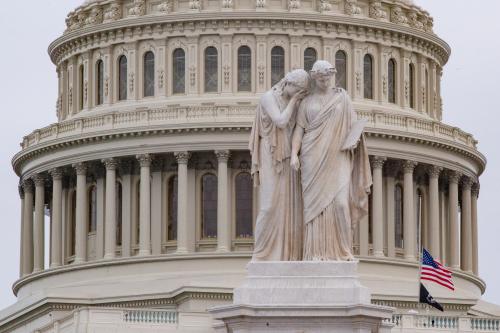
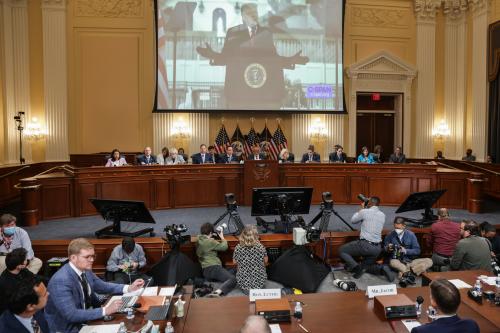
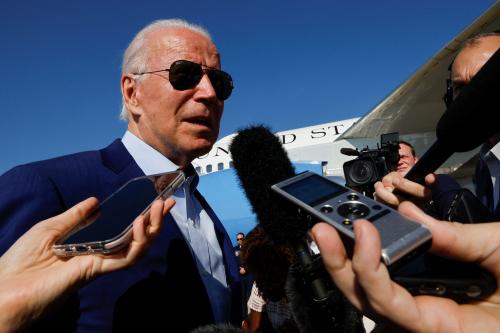
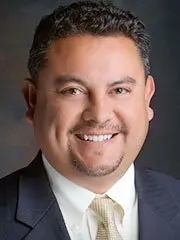

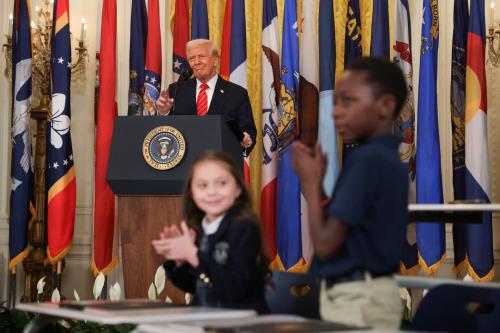

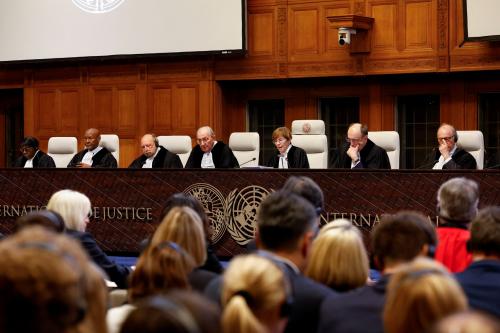
Commentary
Misinformation is eroding the public’s confidence in democracy
July 26, 2022